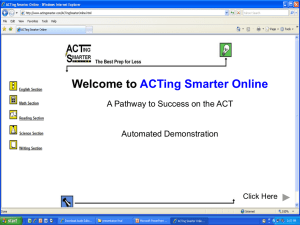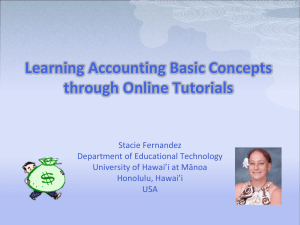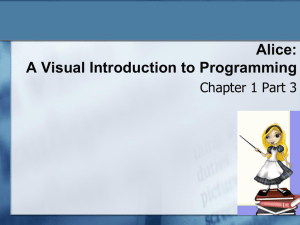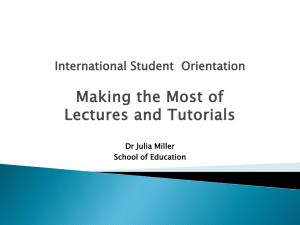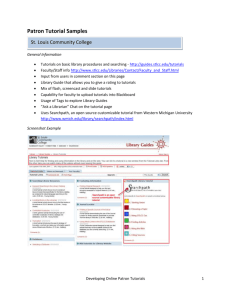Researching and Writing Lesson - 21st-Century
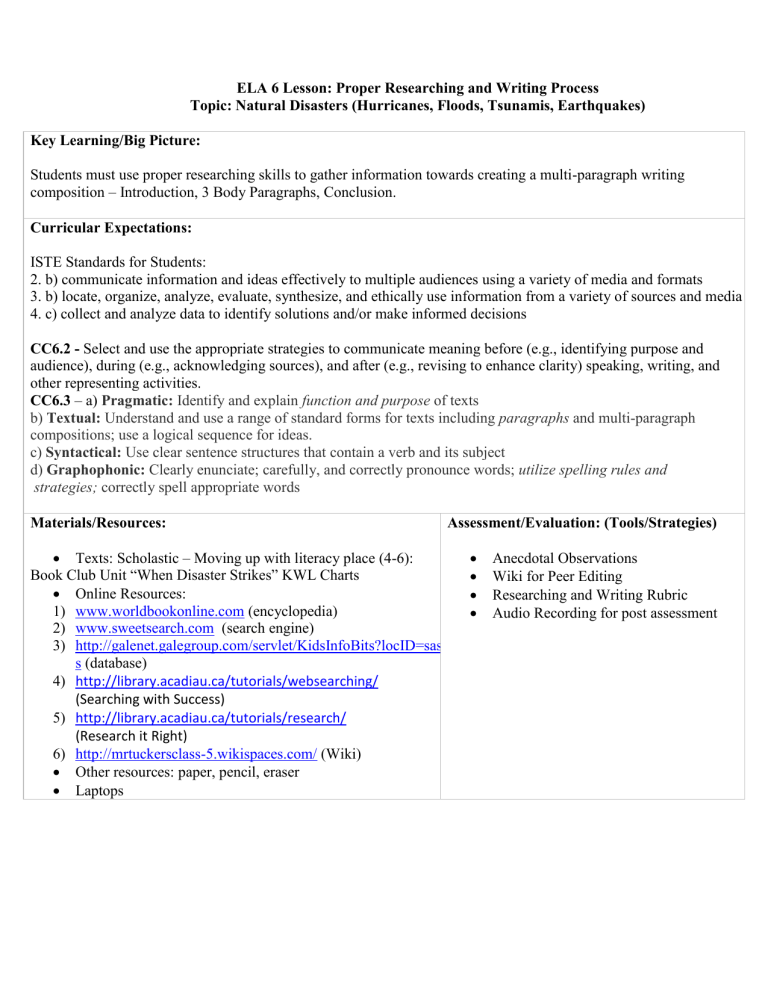
ELA 6 Lesson: Proper Researching and Writing Process
Topic: Natural Disasters (Hurricanes, Floods, Tsunamis, Earthquakes)
Key Learning/Big Picture:
Students must use proper researching skills to gather information towards creating a multi-paragraph writing composition – Introduction, 3 Body Paragraphs, Conclusion.
Curricular Expectations:
ISTE Standards for Students:
2. b) communicate information and ideas effectively to multiple audiences using a variety of media and formats
3. b) locate, organize, analyze, evaluate, synthesize, and ethically use information from a variety of sources and media
4. c) collect and analyze data to identify solutions and/or make informed decisions
CC6.2 - Select and use the appropriate strategies to communicate meaning before (e.g., identifying purpose and audience), during (e.g., acknowledging sources), and after (e.g., revising to enhance clarity) speaking, writing, and other representing activities.
CC6.3
– a)
Pragmatic: Identify and explain function and purpose of texts b) Textual: Understand and use a range of standard forms for texts including paragraphs and multi-paragraph compositions; use a logical sequence for ideas. c) Syntactical: Use clear sentence structures that contain a verb and its subject d) Graphophonic: Clearly enunciate; carefully, and correctly pronounce words; utilize spelling rules and
strategies; correctly spell appropriate words
Materials/Resources:
Book Club Unit “When Disaster Strikes” KWL Charts
Online Resources:
1)
Texts: Scholastic – Moving up with literacy place (4-6): www.worldbookonline.com
(encyclopedia)
Anecdotal Observations
Wiki for Peer Editing
Researching and Writing Rubric
Audio Recording for post assessment
2) www.sweetsearch.com
(search engine)
3) http://galenet.galegroup.com/servlet/KidsInfoBits?locID=saskplschool s (database)
Assessment/Evaluation: (Tools/Strategies)
4) http://library.acadiau.ca/tutorials/websearching/
(Searching with Success)
5) http://library.acadiau.ca/tutorials/research/
(Research it Right)
6) http://mrtuckersclass-5.wikispaces.com/ (Wiki)
Other resources: paper, pencil, eraser
Laptops
Lesson Sequence:
Hook: Discuss their favourite amusement park ride or water park ride, and how they felt when the adrenaline was coursing through them. Then get them to think about a time something bad happened to them. Tell them to imagine both happening at the same time, and how confusing it might be. Introduce the topic.
Before:
1) Activate prior knowledge of the topic through a KWL chart.
2) Read through the newspaper articles on hurricanes, floods, tsunamis, and earthquakes
3) Complete the “What I’ve Learned” section on the KWL chart.
4) Audience: other elementary students their age and parents – make them aware (inform) of these disasters and the effects on people’s lives. Also, thinking about how people can contribute with relief efforts such as volunteering and donations.
5) Handout: “Spectrum Writing 6”: The writing process from pg. 9. Also, I have a bulletin board display that students can refer to:
During
1) Choose one of the topics read above, either hurricanes, floods, tsunamis, or earthquakes
2) Begin the prewriting stage – brainstorming
3) Show tutorials on proper researching skills http://library.acadiau.ca/tutorials/websearching/ (Searching with
Success) and http://library.acadiau.ca/tutorials/research/ (Research it Right)
4) Take the students to the computer lab to search further into their topic. They will use www.worldbookonline.com (encyclopedia), www.sweetsearch.com (search engine), or http://galenet.galegroup.com/servlet/KidsInfoBits?locID=saskplschools (database), and the newspaper articles
5) Handout: “Spectrum Writing 6”: Informational writing from pg. 100 + 101. Once students have sufficient
Information on their topic, they will receive a writing example.
6) Students must create a multi-paragraph writing composition – Introduction, 3 Body Paragraphs, Conclusion.
7) Drafting – put their ideas on paper, form sentences and paragraphs (spelling does not matter)
After
1) Revising – type their draft and make changes to the structure.
2) Peer Editing – Copy/paste their written work into the classroom wiki; whereby other students can edit their work (each student has different coloured text). Look for transition words.
3) Proofreading – print out a good copy and make sure everything is correct and polished (capitals, punctuation, spelling).
4) Publishing – make a final copy that has no mistakes.
5) Present their material either in a poster or speech (CC6.1,6.5,6.6)
6) Audio Record: gather some feedback from students about their learning (“what do you now know that you didn't before”)
Ongoing Assessment:
Provide positive feedback and monitor writing throughout the process
Ask questions to monitor comprehension
Wiki Example:
Accounting for Learning Diversity:
Provide instructions both orally and written
Use the Smart Board to display information
Use of the Internet
